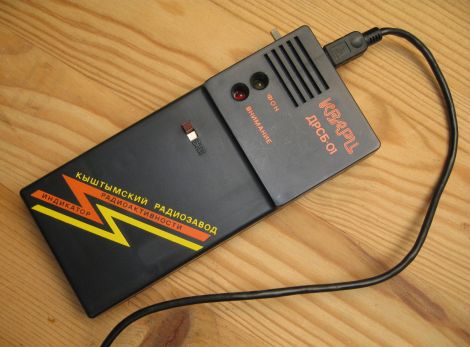
[Vic] bought a Kvarts DRSB-01 Geiger counter a few years ago, and recently dug it out of his electronics stash. The counter is a run of the mil no-frills unit. It lacks any kind of LCD display and it cannot be calibrated, so Sievert exposure ratings are out of the question. The unit essentially monitors background radiation and alerts the user to the presence of gamma and high-energy beta rays via audible clicks.
[Vic] wanted to make it a bit more useful, so he decided to interface it with his computer in order to take long-term radiation measurements. He dug up a schematic online and deadbugged a small circuit using an ATtiny44. The circuit allows him to enumerate the electrical pulses generated by ionizing particles striking the Geiger tube, passing them along to his PC over USB.
The counter seems to interface with the PC just fine, but [Vic] does say that he’s getting some odd readings. He thinks that he might have damaged the tube while messing around, but he’s all ears if you have any insight on the matter.















Would be a cool experiment to hook it up to an android device as an interface to the device. 3.1 has USB support and of course you know about the new support for the ADK
what, no arduino?
Never disregard those odd readings.
it’s Russian… do you have to hit it with a hammer to start it up?
Try taking readings in other locations to see if those odd readings are indeed coming from the environment.
Fukushima anyone?
I did a simpler 1-wire mod a few years ago with the same type of unit.
http://karlander.net/projekt/geiger.html
At least you can hit it with a hammer and it’ll start up…
Not fukushima…
The spurious readings are likely high voltage discharges. Most GM tubes run >500V, so depending on the quality of the construction, HV pops can be frequent. Also, the Sievert is a measure of dose, not a unit for exposure :-)
Yeah, try cleaning the casing, HV section and tube contact areas with IPA, allow to dry.
a diode would prevent the power from the usb from going into the batteries though you will need to add another battery to get over the voltage drop by the diode.
it may be possible to use some kind of transistor setup to detect the usb and disable the batteries.
you can also use a current limiting resistor so you can use rechargeable batteries and not draw too much current from the usb port
hi,
Thanks for the suggestions. The manipulations during construction might well explain the strange readings. The circuit board is actually coated with a varnish that I had to remove partially to make solders (not in the HV section, though), and I probably touched the tube numerous times without thinking about it.
The only other thing I could think of is that it was raining the day there was the biggest reading, and rain is known to cause radon to seep out of the ground in some places … However I live atop a 10 story building in Paris so I doubt that’s it. There’s rain forecast tomorrow so I’ll know for sure :-)
@Richard: nice idea. I’m not convinced by the new ADK, maybe Bluetooth would be better.
@Jeff: thanks for the correction :)
@Jeff
well, as long as we’re being here, the Sievert [Sv] (conventional unit: radiation equivalent man [rem]) is actually the SI unit for dose equivalent. this is like the absorbed dose, but includes a quality factor to account for different biological effects of ionizing radiations (normalized by gamma rays (~100 keV)).
the Gray [Gy] (conventional: radiation absorbed dose [rad]) is the SI unit for absorbed dose.
other relevant units:
(radio)activity (a measure of reaction rate, or more specifically, the decay rate): Becquerel [Bq] (conventional: Curie [Ci])
exposure (measures the specific charge density (charges resulting from ionization by photon interaction) in air): Coulomb per kg of air [C/kg] (conventional: Röntgen [R])
get your units on lockdown, y’all
@Jeff
well, as long as we’re pedantic being here, the Sievert [Sv] (conventional unit: radiation equivalent man [rem]) is actually the SI unit for dose equivalent. this is like the absorbed dose, but includes a quality factor to account for different biological effects of ionizing radiations (normalized by gamma rays (~100 keV)).
the Gray [Gy] (conventional: radiation absorbed dose [rad]) is the SI unit for absorbed dose.
other relevant units:
(radio)activity (a measure of reaction rate, or more specifically, the decay rate): Becquerel [Bq] (conventional: Curie [Ci])
exposure (measures the specific charge density (charges resulting from ionization by photon interaction) in air): Coulomb per kg of air [C/kg] (conventional: Röntgen [R])
get your units on lockdown, y’all
The tube looks like one of low sensitivity contraptions used for hard beta and gamma detection.
If anyone is interested simulators of radioactive pollution propagation is available here:
http://zardoz.nilu.no/~flexpart/fpinteractive/plots/?C=M;O=D
There is more to Fukushima than meets the eye.
Hello, it’s an old thread, but i want add some information.
If there are additional pulses after an ionisation (like frequency generator), then it could be that the gas in the valve is a moment longer ionisated (partly),
When the main pulse has gone, the high voltage reloads, a lower voltage is needed to produce additional pulse(s).
The only sure way is slower reloading after a pulse, so that the the geiger valve can neutralize itself.
Have fun.